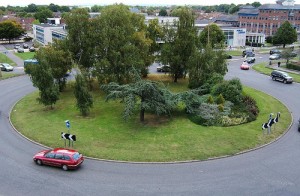The Nobel Prize in Physics and Traffic Priority at Roundabouts
The 2013 Nobel Prize in Physics was recently awarded for symmetry breaking and its consequence, the Higgs boson—a particle so well known that, according to the president of the American Physical Society, “[i]f you’re a physicist, you can’t get in a taxi anywhere in the world without having the driver ask you about the Higgs particle.” Teaching the symmetry unit in my own course this semester, I couldn’t help wondering about symmetry as I drove through an apparent example of symmetry: roundabouts or traffic circles.
Roundabouts use two complementary systems for controlling traffic flow: (1) Traffic in the roundabout has priority, or (2) traffic entering the roundabout has priority. The choice seems so symmetric, like choosing right- or left-hand traffic. In the United Kingdom, traffic in the roundabout has priority. In contrast, on many Massachusetts roundabouts, including one on my commute, entering traffic has priority. At rush hour, as drivers in the roundabout yield to the incoming traffic, the roundabout gets more and more packed, until the flow locks up and spreads the traffic jam to the surrounding roads.
The symmetry, in contrast to right- and left-hand traffic but like the broken symmetry producing the Higgs boson, is broken: There is more space outside than inside the roundabout. Giving priority to drivers exiting the roundabout better uses its limited space. Similarly, passengers exiting an elevator or subway car should have priority over entering passengers—although subway systems, with the incessant announcements to “please let passengers exit the train first,” must loudly remind passengers of the broken symmetry.


Comments